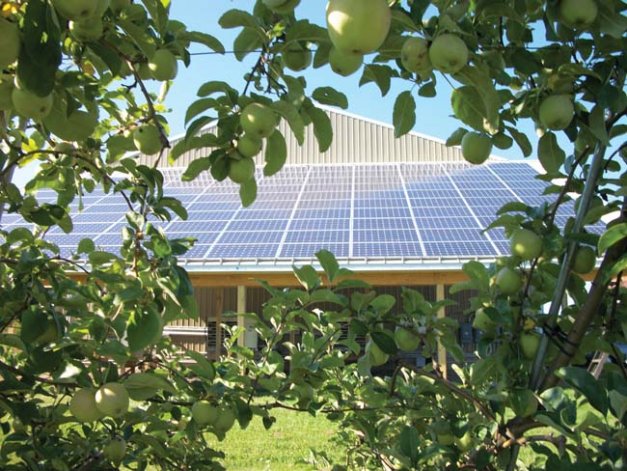
Chip and Karla Bailey saw the potential for generating renewable energy on their farm already in 2001, but it took a while to get there.
After years of research, planning, and persistence, their renewable energy projects were completed last summer when they installed a 15-kilowatt windmill that provides power for the migrant housing complex on the farm where 25 seasonal workers live and for one cold storage there.
They also installed a 25-kilowatt grid-tied solar system consisting of 110 photovoltaic solar panels to provide power for another cold storage and farm shop.
The Baileys grow about 160 acres of apples on KC Bailey Orchards, Inc., in Williamson, New York, and run a vertically integrated business that includes, besides the orchards, bin construction, two on-farm cold storages, trucking, and black locust trellis post production.
Two years ago, the New York State governor announced an initiative called “45 by 15,” a plan to meet 45 percent of the state’s electricity needs by 2015 through improved energy efficiency and clean renewable energy. Two-thirds of that goal is to be met by generating electricity from renewable sources like wind and sunshine.
The Baileys were able to tap into the New York State program and reduce much of the project costs, which were then offset by tax credits and grants, including a 25 percent REAP (Rural Energy for America Program) grant from the USDA’s Rural Development Agency. The Baileys said the payback without assistance would have taken 25 to 30 years, but that time was cut to about 10 years.
One key part is the tie-in to the electrical grid. Many states now have “net metering laws” that require electrical generation companies to buy back electricity produced by their customers—giving them a credit up to the amount they buy. Without that, the Baileys would have had to install a battery storage system that would have increased the cost by a third.
Both wind and sun energy production is variable depending upon weather, time of year, and time of day. The grid tie-in lets the Baileys collect energy when conditions are right and draw off the grid during nights and bad weather.
“There are different energy goals in different states,” Karla Bailey said. “New York has decided it wants distributed generation.” That means more small producers and less reliance on large coal- or nuclear-fueled plants.
In putting in the solar system, the Baileys built a lean-to attached to the south side of the storage. Basically just a roof that will cover an open-sided area for equipment storage, it was built in perfect orientation to the sun and at a slant of 28 degrees, best suited to their area.
The windmill is 120 feet tall and has three 15-foot blades that will generate electricity when winds are at least seven miles per hour. Average wind speed in their location on the southern shore of Lake Ontario is twice that. The windmill shuts down, for safety reasons, when winds exceed 55.
The solar system is expected to generate about 28,000 kilowatts of electricity each year, just over half what the storage requires. The windmill will generate about 35,000 kilowatts per year.
IFTA tour
The Baileys showed their system during the International Fruit Tree Association tour in western New York last summer. The stop included one other highlight: A record-yield orchard.
Planting knip boom trees—Gala on Nic.9 in a 3 x 11 tall spindle spacing—Chip Bailey set the top New York State yield record for the first two crop years, according to Cornell horticulturist Dr. Terence Robinson. He got 240 bushels per acre in the second leaf and 960 in the third.
“I’m going to best that with my new planting,” Chip said.
Robinson is a fan of knip boom, in which trees are headed back and kept in the nursery an additional year.
The trees cost $1.20 more each and are harder to handle because they’re bigger, 6 feet tall, and cost more in freight and handling.
“Everybody in Europe does the knip boom system,” Robinson said. “It’s an instant orchard.”

Leave A Comment